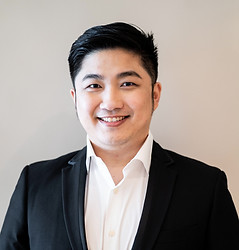Beginning
of Physiotherapy
Year 460 BC
Hippocrates first introduced the idea of manual manipulation for pain relief. Since then, physiotherapy has evolved from simple massage to a complex portfolio of therapies with many specialized applications.
In Ancient Greece, circa 460 BC,
Hector practiced a physiotherapy technique called “hydrotherapy,” – which is Greek for water treatment.
The Greeks, however, were not the only people practicing physical therapy; ancient writings from Persia, China, and Egypt also describe the benefits of exercise, movement, and massage for ailments.

Disclaimers: The images not our creative product, nor intend to sell or profit from the creative and intellectual property of another. Intention goal to appreciate and promote awareness of content.

Year 1813 Swedish Gymnastics
Per Henrik Ling, “Father of Swedish Gymnastics,” who founded the Royal Central Institute of Gymnastics (RCIG) in 1813 for massage, manipulation, and exercise. The Swedish word for physical therapist is sjukgymnast = someone involved in gymnastics for those who are ill.
Pehr Henrik Ling. Artist: Johan Cardon (1802-1878)
A Swedish physiologist pioneered teaching physical education in Sweden and is often referred to as the father of Swedish massage.
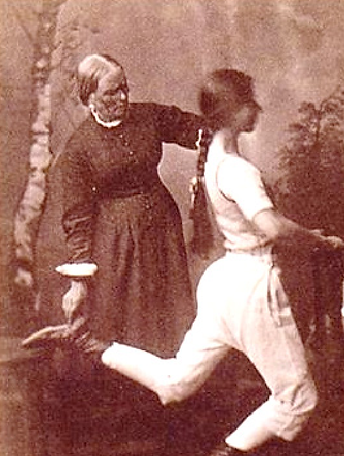

Medical Gymnastics
In International YMCA Training School, now known as Springfield College. The boy on the left has a lame arm, and the boy in the middle has severe scoliosis.
This lantern slide may have been used in the Medical Gymnastics class, which taught students how to treat "bad postural habits . . . deformities, kyphosis, lordosis, [and] scoliosis" with gymnastics. Practitioners also used this treatment "for infantile paralysis, for stiffened joints, for obesity, for constipation, for cardiac weakness and other ailments."
Sources: Springfield College 1905
An ankle exercise guided by Hildur Ling (1825-84) at the Royal Central Gymnastic Institute of Stockholm. Hildur was the daughter of Pehr Henrik Ling.
Sources : Kungliga gymnastiska centralinstitutet, Riksarkivet. 1825-84
Year 1917 - 1918 World War I
The therapy was performed widely to cure people injured in World War I. The treatment was considered ‘rehabilitation therapy‘ during that time.
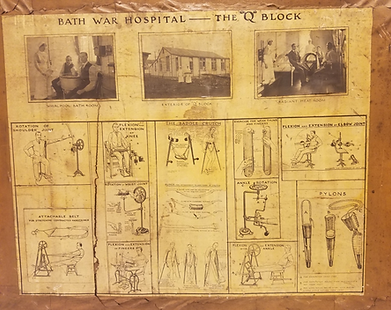
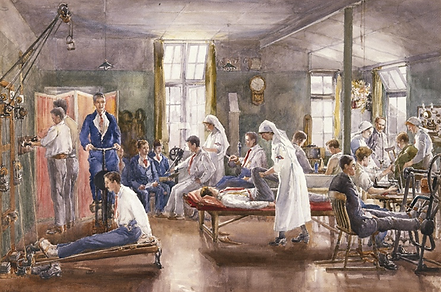
Physical Therapy at Bath War Hospital.
Sources: Watercolor by E.Horton, ca.1918. Wellcome Trust Library
Reverse of Physical Therapy at Bath War Hospital.
Sources: Watercolor by E.Horton. Wellcome Trust Library.
Year 1921 March - Research Published in the Physical Therapy Review - United States.
It was during this time that Mary McMillan, the first physical therapy aide, established the American Women’s Physical Therapeutic Association.
The organization’s name was later on changed to the American Physical Therapy Association (APTA). Due to her significant contribution in the reconstruction aide services, Mary McMillan came to be known as the ‘Mother of Physical Therapy‘.

Sources: The cover of Mary Farrell and Marta M. Mobley's StoryTerrace book
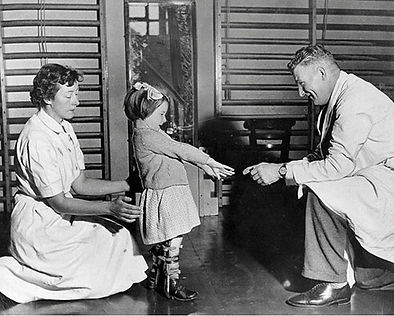
Year 1920 Polio
An outbreak of polio in the 1920s placed increased demand on physical therapists, which led to more breakthroughs in treatment techniques. Additional improvements were seen in the following several decades due to advanced medical and surgical knowledge.
A girl with polio receiving physiotherapy treatment in the 1930s
Disclaimers: The images not our creative product, nor intend to sell or profit from the creative and intellectual property of another. Intention goal to appreciate and promote awareness of content.
.jpg)
Year 1939-1945 World War II
Until the Second World War, most physical therapies were done in hospitals on patients recovering from surgeries, injuries, or other conditions.
Specialty physical therapy clinics were founded during the war to treat the thousands of wounded soldiers who needed rehabilitation following hospital stays. This transition to outpatient care represented the growing popularity of physical therapy.
Disclaimers: The images not our creative product, nor intend to sell or profit from the creative and intellectual property of another. Intention goal to appreciate and promote awareness of content.
Year 1950 - 1980
Until the early 1950s, physical therapy was performed only in hospitals. In the late 1950s, physical therapists started treating patients beyond hospitals.
1963 August, 6 Malaysia Physiotherapy Association (MPA) Registered
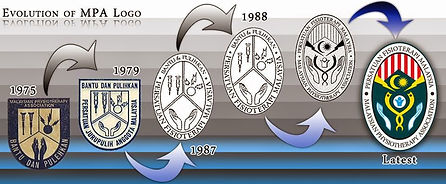
Malaysia Physiotherapy Association (MPA)
Disclaimers: The images not our creative product, nor intend to sell or profit from the creative and intellectual property of another. Intention goal to appreciate and promote awareness of content.

In 1974, Manual Therapy For Orthopedics
Many doctors in the United States specialize in physical therapy. A separate division – the Orthopedic Section – was formed in the APTA for the physical therapists who had specialized in Orthopedics.
Manual therapy was popularized worldwide in 1974 when the ‘International Federation of Orthopedic Manipulative Therapy’ was established.
Disclaimers: The images not our creative product, nor intend to sell or profit from the creative and intellectual property of another. Intention goal to appreciate and promote awareness of content.
Year 1860 -1980 Electrophysical Agent
Further development in physiotherapy was recorded in the 1980s when computers became prevalent in Medical Science. Various devices, such as electrical stimulators, were introduced for practicing physiotherapy, which increased the effectiveness of the treatment.

Disclaimers: The images not our creative product, nor intend to sell or profit from the creative and intellectual property of another. Intention goal to appreciate and promote awareness of content.
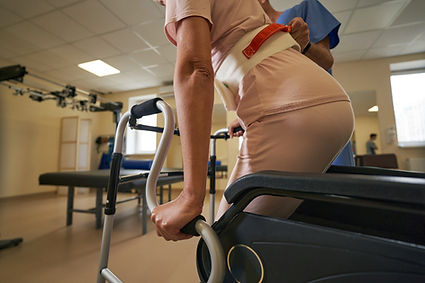
Recovery from Disability
Disclaimers: The images not our creative product, nor intend to sell or profit from the creative and intellectual property of another. Intention goal to appreciate and promote awareness of content.
Year 1981 - 2000 Age of Information Technology
During the next two decades, the profession of physical therapy increasingly diversified. Specializations, such as cardiopulmonary physical therapy, skin therapy, neurological therapy, and sports therapy, were recognized by APTA, and the discipline continued to become more widely regarded.
Physiotherapy is used to treat a variety of ailments and conditions. Patients may seek treatment for scoliosis, back pain, osteoarthritis, Alzheimer’s disease, Parkinson’s disease, bursitis, muscle strains, Guillain-Barre syndrome, balance conditions, asthma, fibromyalgia, wounds, burns, rheumatoid arthritis, and a host of other conditions.
The goals of physiotherapy depend on the patient’s unique needs. Still, expected desired outcomes include a reduction in pain, increased range of motion, increased endurance and strength, restored independence, decreased stress, and a greater quality of life for the patient.
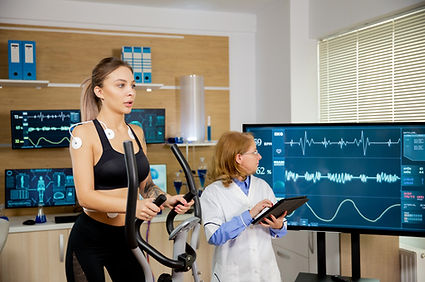
Cardiorespiratory Fitness
Disclaimers: The images not our creative product, nor intend to sell or profit from the creative and intellectual property of another. Intention goal to appreciate and promote awareness of content.
Year 2000 - 2021 Data Technology Age and Holistic Health
As professional health data is vastly available at the tip of the hand, the field of physiotherapy evolved even further.
The advent of the data technology age made possible by faster, safer, and cheaper access to care allowed for virtual health care and better health awareness. The faster injury recovery process, shorter discharge duration as well as longer age of retirement are examples of some of the advancements that increased effectiveness in treatment.
While physiotherapy and orthopedic have continued to grow ineffective treatments and therapy, another area of specialization has formed. The field of Sports Medicine, Health Inspired by Cosmetic Orthopedic Surgery, and the advancement of Physical Therapy Science have developed into a highly effective means of treating individuals of all ages, from newborns to sports players and people at the end of life.
A physiotherapist is a movement specialist who improves the quality of life through prescribed corrective exercises, electrotherapy, hands-on care, and patient education. Also, people simply want to become healthier and prevent future problems for longevity.

